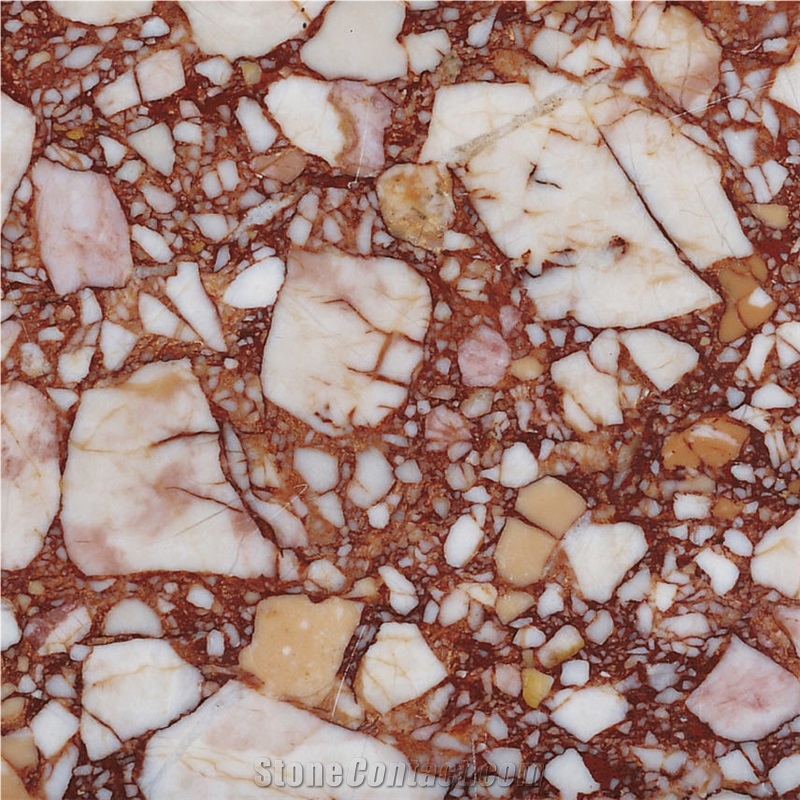Can France's Breche de Guillestre Marble be used exterior applications in very rainy climates?
Breche de Guillestre Marble, also known as Sarrancolin Breche Marble, is a type of marble that originates from the Hautes-Alpes region in France. It is a unique and beautiful stone often used for interior applications such as countertops, flooring, and wall cladding.
While it is possible to use Breche de Guillestre Marble for exterior applications in rainy climates, it is important to consider a few factors:
1. Porosity: Marble is a natural stone that can be porous, meaning it has tiny openings that can absorb water. In very rainy climates, the constant exposure to water may cause the marble to absorb water and potentially lead to staining, discoloration, or damage over time. Therefore, it is recommended to use proper sealants and maintenance procedures to minimize water absorption.
2. Slip Resistance: When using marble in exterior applications, it is crucial to consider its slip resistance. In rainy climates, surfaces can become slippery when wet, which can increase the risk of accidents. To enhance traction, honing or adding a textured finish to the marble can help provide better slip resistance.
3. Durability: Breche de Guillestre Marble is considered a strong and durable material, suitable for a variety of applications. However, constant exposure to rain, harsh weather conditions, and freeze-thaw cycles can impact the longevity of the stone. Regular maintenance, including resealing, may be required to ensure its durability.
4. Color Stability: Some marble varieties, including Breche de Guillestre Marble, may have certain minerals or veining patterns that can be sensitive to UV radiation. Prolonged exposure to sunlight may cause the stone to fade or undergo color changes over time. To mitigate this issue, proper maintenance and preventative measures, such as regularly applying a UV-protective sealant, can help maintain its original appearance.
In summary, while Breche de Guillestre Marble can be used for exterior applications in rainy climates, it requires careful consideration of its porosity, slip resistance, durability, and color stability. Consulting with a professional stone supplier or installer familiar with the specific marble variety and the climate conditions is recommended to ensure the best outcome.
Breche de Guillestre Marble, also known as Sarrancolin Breche Marble, is a type of marble that originates from the Hautes-Alpes region in France. It is a unique and beautiful stone often used for interior applications such as countertops, flooring, and wall cladding.
While it is possible to use Breche de Guillestre Marble for exterior applications in rainy climates, it is important to consider a few factors:
1. Porosity: Marble is a natural stone that can be porous, meaning it has tiny openings that can absorb water. In very rainy climates, the constant exposure to water may cause the marble to absorb water and potentially lead to staining, discoloration, or damage over time. Therefore, it is recommended to use proper sealants and maintenance procedures to minimize water absorption.
2. Slip Resistance: When using marble in exterior applications, it is crucial to consider its slip resistance. In rainy climates, surfaces can become slippery when wet, which can increase the risk of accidents. To enhance traction, honing or adding a textured finish to the marble can help provide better slip resistance.
3. Durability: Breche de Guillestre Marble is considered a strong and durable material, suitable for a variety of applications. However, constant exposure to rain, harsh weather conditions, and freeze-thaw cycles can impact the longevity of the stone. Regular maintenance, including resealing, may be required to ensure its durability.
4. Color Stability: Some marble varieties, including Breche de Guillestre Marble, may have certain minerals or veining patterns that can be sensitive to UV radiation. Prolonged exposure to sunlight may cause the stone to fade or undergo color changes over time. To mitigate this issue, proper maintenance and preventative measures, such as regularly applying a UV-protective sealant, can help maintain its original appearance.
In summary, while Breche de Guillestre Marble can be used for exterior applications in rainy climates, it requires careful consideration of its porosity, slip resistance, durability, and color stability. Consulting with a professional stone supplier or installer familiar with the specific marble variety and the climate conditions is recommended to ensure the best outcome.
 France
(Guillestre, Col de Vars, Dep. Hautes-Alpes, Provence)
France
(Guillestre, Col de Vars, Dep. Hautes-Alpes, Provence)















